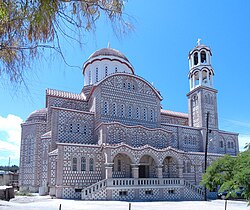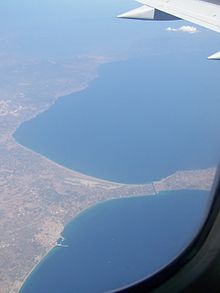Nea Potidea
|
Nea Potidea Νέα Ποτίδαια (Τοπική Κοινότητα Νέας Ποτειδαίας) |
||
|---|---|---|
|
|
||
| Basic data | ||
| Country |
|
|
| region | Central Macedonia | |
| Regional district | Chalkidiki | |
| local community | Nea Propondida | |
| Parish | Moudania | |
| Geographic coordinates | 40 ° 12 ′ N , 23 ° 20 ′ E | |
| Height above d. M. |
20 m local area |
|
| surface | 17.767 km² | |
| Residents | 1559 (2011) | |
| Population density | 87.75 inhabitants / km² | |
| Church of Nea Potidea, north side | ||
Nea Potidea ( Greek Νέα Ποτίδαια ( f. Sg. ); Alternative and at the same time ancient name Potidaia Ποτίδαια or Poteidaia , Latin Potidaea ) is a place on the Greek peninsula of Chalkidiki . It is located at the narrowest point to the transition ( isthmus ) to the Kassandra peninsula, which is only 1 km wide at this point. Immediately north of the village, the Potidea Canal runs from west to east .
history
Ancient Potidea
Potidea was founded around the year 600 BC. Founded by settlers from Corinth . The colony lived mainly from trade with the neighboring realm of Macedonia. As a result, she achieved great prosperity and 550 BC. A mint was even built. 479 BC The city was saved from the Persians by a tsunami .
Potidaia played an important role in the early phase of the Peloponnesian War : the city was a member of the Attic League and at the same time maintained good relations with the mother city of Corinth. Since there was an increasing antagonism between Athens and Corinth, an ally of Sparta , Athens demanded from Potidaia that it should expel its Corinthian officials and razor its walls. Potidaia rejected this interference in his autonomy rights and declared his separation from the Attic League. Thereupon the Athenians marched against the city and besieged it. After two years, the Athenians succeeded in 430 BC The capture of the city, which they took until 404 BC. Could hold.
From 363 BC The city was again owned by the Athenians. But then it came into focus of the expansion efforts of the Macedonians under their king Philip II , the 356 BC. The conquest of Potidaia succeeded. He had the city destroyed and the territory assigned to the city of Olynthos .
Kassandreia
In place of the old Potidaia, the Macedonian king Cassander in 316 BC. A new city, which he named after himself Kassandreia . In the following time the ship industry grew there, which led to new prosperity in the city. After the Battle of Pydna in 168 BC. BC it was occupied by the Romans. After the Turkish conquest in 1430, the city was abandoned and fell into disrepair.
Nea Potidea
In 1922 refugees from Eastern Thrace settled in the area of the city of Kassandreia. In 1931 they dug the canal as it runs today. The place has had two bridges over the canal and a small fishing port since 2002. It is connected to Thessaloniki by an 80 km long motorway-like expressway (extension of national road 67 ) . The fort from the Roman period has been preserved and a small remnant of the city wall is still left.
literature
- Andreas Neumeier: Chalkidiki. 4th, updated and revised edition. M. Müller, Erlangen 2006, ISBN 3-89953-256-2 .
Web links
Individual evidence
- ↑ Results of the 2011 census at the National Statistical Service of Greece (ΕΛ.ΣΤΑΤ) ( Memento from June 27, 2015 in the Internet Archive ) (Excel document, 2.6 MB)
- ↑ Herodotus: The Histories. 8,129
- ^ TC Smid: Tsunamis in Greek Literature. In: Greece & Rome. 2nd Series, Vol. 17, No. 1, April 1970, pp. 100-104, here pp. 102 f., Doi : 10.1017 / S0017383500017393 .


